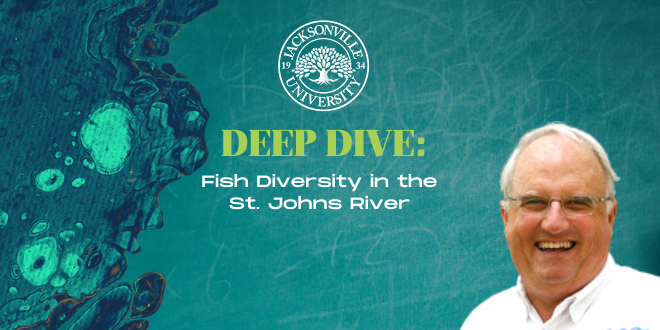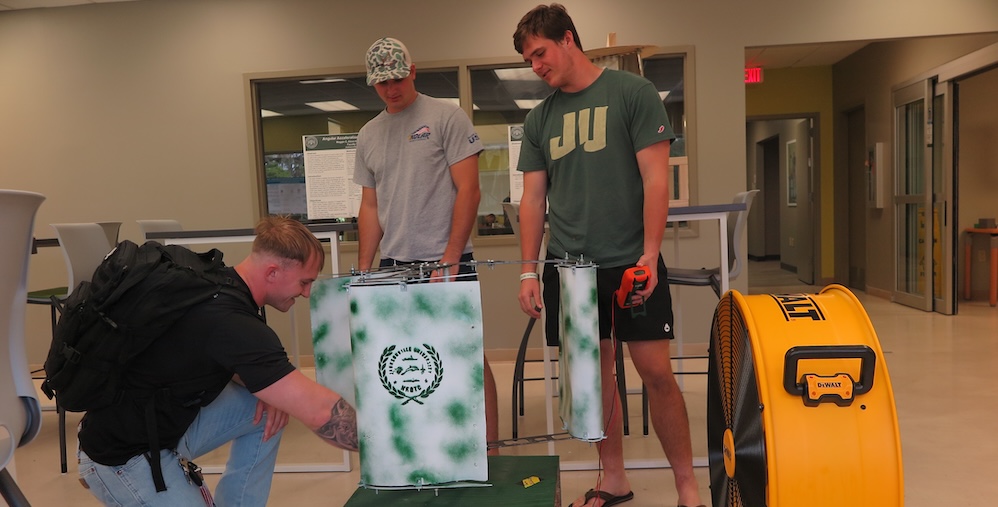One of the more enjoyable things I do as a marine scientist who studies the St. Johns River is to take students of all ages, out on the river to see and experience the wonder of this resource. I say students of all ages, because we take adults from Jacksonville on river cruises who have never been on the river. They have driven over it, beside it and along it, but have never been ON it.
Last month, we had a group of middle school age students who were visiting Jacksonville from western North Carolina. They attend a Quaker School and one topic in their curriculum was coastal ecology. They had written to ask if my colleague, Dr. Gerry Pinto, and I could talk to them about the river and northeast Florida ecology. We jumped at the chance and also asked if they would be interested in doing a river cruise. Back came an enthusiastic, “yes.”
So when they arrived, we took them on the R/V Larkin. She is a 48 ft. catamaran that we use as a floating classroom. By the way, ships and boats are always referred to as female in maritime heritage, probably linked to their grace and beauty, along with the strength and protection associated with mothers, like Mother Nature. We were able to give them a tour of the river, pull an otter trawl, and do a plankton tow.
Pulling an otter trawl is always an adventure. You never know what you will encounter and catch. Otter trawls get their name from the otter, or doors, that are rigged to keep the net open. Across the top of the net are a series of floats and the bottom is weighed down with a series of lead weights, or chain. As you tow the net, if all goes well, and you don’t snag on some submerged object that rips a hole in the net, you might catch a variety of creatures. Our tow that day was a success and no torn nets.
We managed to catch a small blue crab and a sting ray along with a variety of fish and a number of shrimp. We were telling the students to be careful with the sting ray and the blue crab to avoid a painful injury, when almost as if we had planned it, the blue crab pinched me. I was smart enough to be wearing gloves, but it did make a comical, and not too painful, teachable moment.
Among the fish species collected were a small flounder, several lizard fish, some juvenile croakers, and killifish. We were able to explain that this part of the St. Johns River is an estuary, or a semi-enclosed body of water, open to the ocean, but diluted with fresh water. I was impressed that these land-locked students knew that full-strength sea water had a salinity, or salt content, of 35 parts per thousand. So the idea of brackish water was not foreign to them.
We explained that some fish are called stenohaline and only able to withstand a narrow range of salinity. Some fish are limited to fresh water and cannot stand much salt, while some need full strength seawater to survive. The species we collected that day were euryhaline and able to withstand a wide variety of salinities from freshwater to the ocean.
As I said in the opening paragraph, one of the more enjoyable things I am able to do as a marine scientist who studies the St. Johns River is to take students of all ages out on the river to see and experience the wonder of the river.
Glad you asked River Life
Any update on the sturgeon reported found in the St. Johns River in January?
Florida Fish and Wildlife biologists were able to recover the carcass and identified it as an Atlantic Sturgeon (Acipenser oxyrinchus oxyrinchus). And as mentioned last month in River Life, it is a federally endangered species and encouraging to find one in the St. Johns River.
The Atlantic Sturgeon is euryhaline and inhabits both salt and freshwater habitats, often moving between the two seasonally, with brackish and saltwater in the fall and winter then back into freshwater rivers during the spring.


